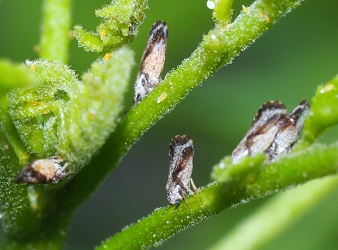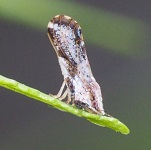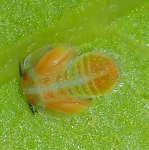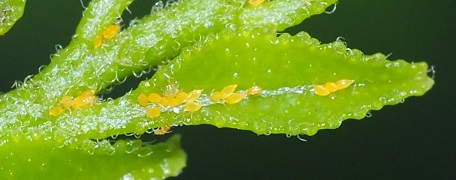| Home | Nature Weekly Index |
25 October 2020 | Asian Citrus Psyllid | Diaphorina citri |


 When I saw the
Asian Citrus Psyllid (Diaphorina citri)
for the first time on the pot of
Indian Curry Tree (Murraya koenigii) located along my
balcony area, its identity was unknown to me. I had mistaken it to be an insect from the
suborder Auchenorrhyncha that consists of cicadas,
leafhoppers, treehoppers, planthoppers, and spittlebugs. In actual fact, it is classified under the
suborder Sternorrhyncha that consists of aphids,
whiteflies, and scale insects.
When I saw the
Asian Citrus Psyllid (Diaphorina citri)
for the first time on the pot of
Indian Curry Tree (Murraya koenigii) located along my
balcony area, its identity was unknown to me. I had mistaken it to be an insect from the
suborder Auchenorrhyncha that consists of cicadas,
leafhoppers, treehoppers, planthoppers, and spittlebugs. In actual fact, it is classified under the
suborder Sternorrhyncha that consists of aphids,
whiteflies, and scale insects.
The adult with a body length of 3 to 4 millimetres was considered a giant among the other tiny psyllids in the superfamily Psylloidea. It was easily visible especially with the mottled brown body in contrast of the green background of the leaves. It typically positions its head region on the surface of the leaf or twig with its tail end pointing toward the air which I understood to be its feeding posture.
Since there were many of them on the plant including nymphs and eggs, the Indian Curry Tree should be one of its host plants. As its common name implied, it attacks citrus plants from the family Rutaceae. The Indian Curry Tree happens to be a member of this family. Another common pest of Indian Curry Tree is Tortoise Beetle (Silana farinosa).
 When I adopted the pot of Indian Curry Tree, the leaves were full of whiteflies. I cut off the top part of the plant
and removed all remaining leaves, leaving just the stem for it to re-grow. The leaves grew back after a few
weeks but the whiteflies returned soon after. Eventually, I had to try an off-the-shelf anti-scales concoction
which contained "97% petroleum oil (mineral oil)" made by Singapore Hoti-Flora. After mixing the concentrated
solution in water based on the instruction on the label, I gave the plant a thorough spray on 4 October.
Magically, the whiteflies were gone in the next few days and did not return at the time when I penned this note.
It was during my battle with the whiteflies that I noticed the Asian Citrus Psyllid on the plant.
When I adopted the pot of Indian Curry Tree, the leaves were full of whiteflies. I cut off the top part of the plant
and removed all remaining leaves, leaving just the stem for it to re-grow. The leaves grew back after a few
weeks but the whiteflies returned soon after. Eventually, I had to try an off-the-shelf anti-scales concoction
which contained "97% petroleum oil (mineral oil)" made by Singapore Hoti-Flora. After mixing the concentrated
solution in water based on the instruction on the label, I gave the plant a thorough spray on 4 October.
Magically, the whiteflies were gone in the next few days and did not return at the time when I penned this note.
It was during my battle with the whiteflies that I noticed the Asian Citrus Psyllid on the plant.
The population of the Asian Citrus Psyllid continued to be increased over time with many yellowish eggs found on the young leaves of the Indian Curry Tree. I will do a spray of the plant soon with the same concoction that I used to manage the whiteflies and hopefully the potion will also work on this psyllid.